Research
Current projects
Egyptian Glass at the Freer Gallery of Art

Drawer before rehousing
In 1909, Charles Lang Freer bought a collection of 1,388 ancient glass beads, vessels, and mosaic fragments in Cairo, Egypt. Until 2013, the collection was largely left unstudied and was inappropriately stored. As a result, the Freer|Sackler Department of Conservation and Scientific Research is rehousing and researching the collection. This poster, presented at the American Institute for Conservation of Historic and Artistic Works Annual Meeting in May 2015, focuses on the storage project, the challenges associated with rehousing a large collection of small objects, and historical and technical research.
view poster (PDF)
The so-called ‘Indo-Persian’ carpets
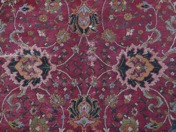
Carpet fragment detail
International trade and political stability in 16th-century Iran gave rise to new economic developments, including textile production. The new Safavid rulers saw this moment as the ideal opportunity to develop the Iranian carpet industry to respond to the demands and competitiveness of the international market. Aiming to look at this transformation during the 16th and 17th centuries, this project takes an interdisciplinary approach involving material science, art history and history to the study of these carpets from Portuguese and USA collections. The results will contribute to a better understanding of the impact of the new overseas trade networks in the development of one of the great forms of artistic expression in Iran.
Raquel Santos presented at the 43rd annual meeting of the American Institute for Conservation of Historic and Artistic Works. view poster (PDF)
Persian minai ceramics
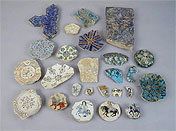
Minai ceramic
Persian minai ceramics produced during the late twelfth and early thirteenth centuries are decorated with multicolored enamel overglazes and gilding on an opaque white ground. These ceramics are often referred to as haft-rang, or "seven-colored," due to the use of black, red, blue, turquoise, green, purple, brown, and white glazes, which create remarkably detailed objects adorned with figural and geometric designs. Analysis of the materials and techniques of these ceramics is underway.
Recent projects
Chinese Buddhist stone sculpture
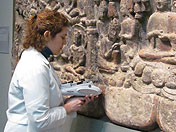
Elemental composition is obtained using a handheld x-ray fluorescence spectrometer
Scientific research on the materials used in Chinese Buddhist stone sculpture is currently in progress. This study will illuminate the types of limestone and sandstone used for carving at some of the major Buddhist temple cave sites in Shanxi, Hebei, and Henan provinces dating from the Northern Wei to the Northern Qi dynasties, including North and South Xiangtangshan, Yungang, Longmen, Gongyi, and Tianlongshan. Analytical methods are being used to compare the materials of sculptures from the Freer Gallery's collection with those from temple cave sites. The results, correlated with previous art-historical attributions, will allow the sculptures to be assigned to specific cave sites of origin. This project will aid research on the Freer Gallery's collection—especially in light of the upcoming exhibition on the temple caves of Xiangtangshan—as well as create a framework for the study of Buddhist stone sculpture in other Western museum collections.
Central Asian ikat textiles
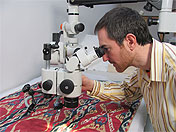
Examination of a Central Asian ikat using a stereomicroscope
Ikats from Central Asia were typically dyed with natural materials found in insects and plants, such as cochineal, madder, and indigo. Because most of the sixty-five ikat textiles in the Freer and Sackler's collection are from the nineteenth and twentieth centuries, however, care must be taken to not overlook the use of available synthetic dyes. Fourier transform infrared spectroscopy, high performance liquid chromatography, and UV-Visible spectroscopy are being used to differentiate and identify the synthetic and/or natural dyes found in the collection's ikat textiles. The information collected will be used by conservators during repair and restoration to ensure the same mixture of colorants is used as those incorporated by the artist.
Synthetics such as aniline dyes were invented and developed in the mid-nineteenth century, and may have been incorporated into works of art to reduce costs, improve color fastness or consistency, or to access new shades. The analytical data on ikat silks of the nineteenth century will also be used to track the movement of synthetic dyes from Europe into East Asia.
Chinese cinnabar and vermilion
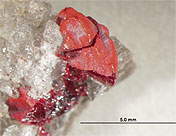
Natural cinnabar, HgS, from Hebei province, China.
Both natural (cinnabar) and synthetic (vermilion) forms of the red pigment mercury II sulfide, HgS, are known to have been used in China, where the pigment occurs widely in archaeological contexts. The existence of impurities or differences in the particle size have been used to differentiate the Chinese dry-process of manufacturing and natural cinnabar, but this method is not always successful due to inclusion of grinding or size classification steps, or the presence of contaminants in processed vermilion. In this study to determine differences between natural and synthetic forms of the pigment, several samples were analyzed using isotope ratio mass spectrometry (IRMS) at the Smithsonian Stable Isotope Mass Spec Laboratory. Studies of trace elements in the samples are underway using x-ray fluorescence spectroscopy (XRF) and electron microprobe at the Smithsonian National Museum of Natural History, as well as Raman spectroscopy at the Smithsonian Museum Conservation Institute. The goal of the research is to develop a method that will discriminate between the two forms of the pigment, and possibly identify geological sources of mercury sulfide given sufficient analyses of raw materials.
Khmer stone sculpture
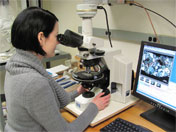
Petrographic analysis of thin sections of Khmer sculpture
Beside stylistic and iconographic studies, petrographic analysis is a fruitful approach to studying Khmer stone sculpture and the sandstone materials with which they are composed. A petrographic classification of sandstones used by the Khmers for sculptural purposes would be a helpful tool for archaeologists, museum curators, and others interested in pursuing research on early stone usage, geologic source, and provenance. Collaborative research is underway to pursue creating such a classification, conducted within the context of our current knowledge about regional geology and ancient quarrying in Cambodia. Petrographic study includes freestanding sculpture of pre-Angkor, Koh Ker, and Bayon styles, as well as the special variety of sculptural arts represented in architectural decorative lintels. The large data set on stone materials offers invaluable support to current archaeological excavations in Southeast Asia.
Chinese jade
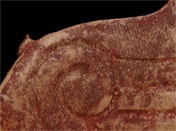
Textile ghost in cinnabar accretions on a Western Zhou jade plaque
Together, the ancient Chinese jade collections of the Freer and Sackler Galleries and the Art Institute of Chicago (AIC) comprise an unusually large and extraordinary group of these objects in the West. Through a collaborative project with the AIC and Northwestern University, an integrated analytical approach has been chosen for the characterization of Chinese jades composed of nephrite. Samples, encompassing both geological reference specimens and museum objects, were studied to understand the characteristics of natural color variations induced by cationic substitutions, as well as human-induced alteration such as heating. Non-invasive methods of analysis were employed, including x-ray fluorescence spectroscopy, Raman microspectroscopy, visible reflectance spectroscopy, and x-ray diffraction. A related project focused on the textile ghosts on archaeological jades left from degraded silk fabric that had been in contact with jades in the burial environment.







